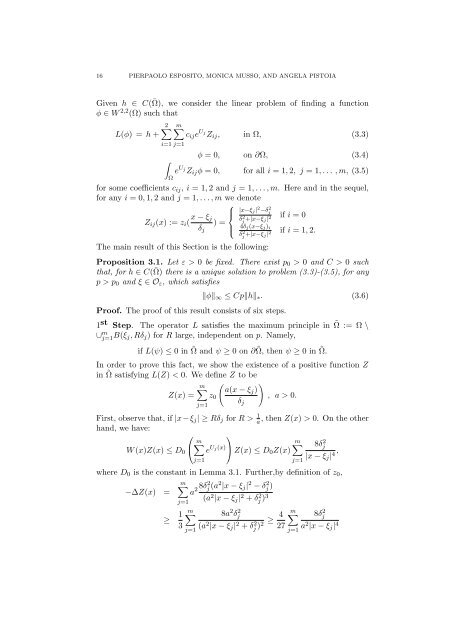CONCENTRATING SOLUTIONS FOR A PLANAR ... - CAPDE
CONCENTRATING SOLUTIONS FOR A PLANAR ... - CAPDE
CONCENTRATING SOLUTIONS FOR A PLANAR ... - CAPDE
Create successful ePaper yourself
Turn your PDF publications into a flip-book with our unique Google optimized e-Paper software.
16 PIERPAOLO ESPOSITO, MONICA MUSSO, AND ANGELA PISTOIA<br />
Given h ∈ C(¯Ω), we consider the linear problem of finding a function<br />
φ ∈ W 2,2 (Ω) such that<br />
2∑ m∑<br />
L(φ) = h + c ij e U j<br />
Z ij , in Ω, (3.3)<br />
i=1 j=1<br />
∫<br />
φ = 0, on ∂Ω, (3.4)<br />
e U j<br />
Z ij φ = 0, for all i = 1, 2, j = 1, . . . , m, (3.5)<br />
Ω<br />
for some coefficients c ij , i = 1, 2 and j = 1, . . . , m. Here and in the sequel,<br />
for any i = 0, 1, 2 and j = 1, . . . , m we denote<br />
⎧<br />
⎪⎨<br />
Z ij (x) := z i ( x − ξ j<br />
δ j<br />
) =<br />
The main result of this Section is the following:<br />
⎪⎩<br />
|x−ξ j | 2 −δ 2 j<br />
δ 2 j +|x−ξ j| 2 if i = 0<br />
4δ j (x−ξ j ) i<br />
δ 2 j +|x−ξ j| 2 if i = 1, 2.<br />
Proposition 3.1. Let ε > 0 be fixed. There exist p 0 > 0 and C > 0 such<br />
that, for h ∈ C(¯Ω) there is a unique solution to problem (3.3)-(3.5), for any<br />
p > p 0 and ξ ∈ O ε , which satisfies<br />
‖φ‖ ∞ ≤ Cp‖h‖ ∗ . (3.6)<br />
Proof. The proof of this result consists of six steps.<br />
1 st Step. The operator L satisfies the maximum principle in ˜Ω := Ω \<br />
∪ m j=1 B(ξ j, Rδ j ) for R large, independent on p. Namely,<br />
if L(ψ) ≤ 0 in ˜Ω and ψ ≥ 0 on ∂ ˜Ω, then ψ ≥ 0 in ˜Ω.<br />
In order to prove this fact, we show the existence of a positive function Z<br />
in ˜Ω satisfying L(Z) < 0. We define Z to be<br />
( )<br />
m∑ a(x − ξj )<br />
Z(x) = z 0 , a > 0.<br />
δ j<br />
j=1<br />
First, observe that, if |x−ξ j | ≥ Rδ j for R > 1 a<br />
, then Z(x) > 0. On the other<br />
hand, we have:<br />
⎛<br />
m∑<br />
W (x)Z(x) ≤ D 0 ⎝<br />
e U j(x)<br />
j=1<br />
⎞<br />
⎠ Z(x) ≤ D 0 Z(x)<br />
m∑<br />
j=1<br />
8δ 2 j<br />
|x − ξ j | 4 ,<br />
where D 0 is the constant in Lemma 3.1. Further,by definition of z 0 ,<br />
m∑<br />
−∆Z(x) = a 2 8δ2 j (a2 |x − ξ j | 2 − δj 2)<br />
(a 2 |x − ξ j | 2 + δj 2)3<br />
≥ 1 3<br />
j=1<br />
m∑<br />
j=1<br />
8a 2 δ 2 j<br />
(a 2 |x − ξ j | 2 + δ 2 j )2 ≥ 4 27<br />
m∑<br />
j=1<br />
8δ 2 j<br />
a 2 |x − ξ j | 4





